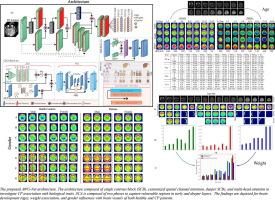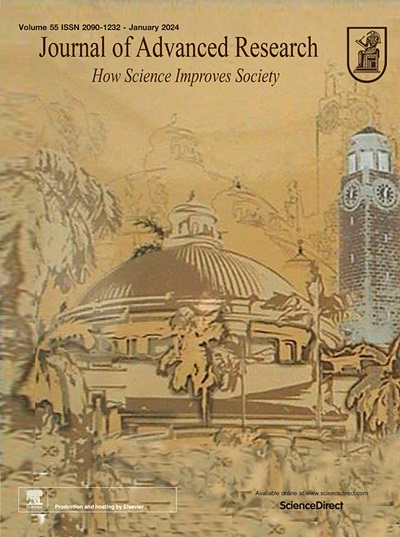关注与脑瘫障碍和生物标记相关的易受损脑区
IF 11.4
1区 综合性期刊
Q1 MULTIDISCIPLINARY SCIENCES
引用次数: 0
摘要
导言:脑瘫(CP)是一种神经系统疾病,由胎儿大脑发育过程中的脑缺血和缺氧引起。早期干预 CP 有利于药物和治疗,但检测 CP 的早期脑发育至关重要。彻底检查与生物特征(BTs)相关的脑损伤区域是不可避免的。在 CP 儿童中,生物特质的变化非常明显;然而,探索生物特质对健康对照组(HC)和 CP 发育障碍儿童大脑的影响至关重要。本研究调查了BTs对HC和CP儿童神经发育的影响。方法:引入的 AWG-Net 由定制空间通道(CSC)和多头自我(MHA)关注组成,其中 CSC 块在前几个阶段加入,MAH 在后期加入,累积密集结构将易感区域传播到更深的层。训练样本包括 T1-w、T2-w、Flair 和 Sag,并标注了年龄、性别和体重。结果:HC 和 CP 的显著结果是年龄(HC:MAE=1.05,MCS10=85.63,R2=0.844;CP:MAE=1.16,MCS10=84.79,R2=0.717)、性别(HC:Acc=82.98%,CP:Acc=82.00%)和体重(HC:MAE=4.65,MCS10=56.30,R2=0.78;CP:MAE=2.85,MCS10=70.24,R2=0.82)。年龄易受影响的区域是 OC 的小脑半球、额骨、枕骨和顶骨,而 CP 则不一致。HC 和 OP 的共同点在于 HC 的额骨和小脑半球,而 CP 的枕骨和颞骨则存在差异。结论:与体重估计相比,年龄和性别对易受 CP 影响的脑区的影响略小。T1-w 适合年龄、体重和性别。在脑发育和性别方面,HC 和 CP 的学习趋势不同,而在体重方面则略有不同。本文章由计算机程序翻译,如有差异,请以英文原文为准。

Attention Over Vulnerable Brain Regions Associating Cerebral Palsy Disorder and Biological Markers
Introduction:
Cerebral palsy (CP) is a neurological disorder caused by cerebral ischemia and hypoxia during fetal brain development. Early intervention in CP favors medications and therapy; however, detecting early brain development with CP is critical. It is inevitable to thoroughly examine brain-vulnerable regions associated with biological traits (BTs). Variations in BTs were evident in children with CP; however, it is critical to explore the BTs’ impact on the brains of health controls (HC) and CP-disordered children.Objective:
This study associates BTs with HC and CP children. This study investigates the neurodevelopment of HC and CP underlying BTs. This study establishes a benchmark of BT’s association and HC and CP children.Method:
The introduced AWG-Net is composed of customized spatial-channel (CSC) and multi-head self (MHA) attentions, where CSC blocks are incorporated at the first few stages, MAH at later stages, and cumulative-dense structures to propagate susceptible regions to deeper layers. The training samples include T1-w, T2-w, Flair, and Sag, annotated with age, gender, and weight.Results:
The significant results for HC and CP are Age (HC: MAE=1.05, MCS10=85.63, R2=0.844; CP: MAE=1.16, MCS10=84.79, R2=0.717), gender (HC: Acc=82.98%, CP: Acc= 82.00%), and weight (HC: MAE=4.65, MCS10=56.30, R2=0.78; CP: MAE=2.85, MCS10=70.24, R2=0.82). Vulnerable regions for age are the cerebellar hemisphere, frontal, occipital, and parietal bones in OC and inconsistent in CP. HC and OP commonalities are in the frontal bone and cerebellar hemisphere with HC and discrepant in the occipital and temporal bones for CP. Similarly, gender differences are found for HC and CP.Conclusion:
Age and gender are marginally less affected by the brain regions vulnerable to CP than weight estimation. T1-w is appropriate for age, weight, and gender. The learned trends are different for HC and CP in brain development and gender while slightly different in the case of weight.求助全文
通过发布文献求助,成功后即可免费获取论文全文。
去求助
来源期刊

Journal of Advanced Research
Multidisciplinary-Multidisciplinary
CiteScore
21.60
自引率
0.90%
发文量
280
审稿时长
12 weeks
期刊介绍:
Journal of Advanced Research (J. Adv. Res.) is an applied/natural sciences, peer-reviewed journal that focuses on interdisciplinary research. The journal aims to contribute to applied research and knowledge worldwide through the publication of original and high-quality research articles in the fields of Medicine, Pharmaceutical Sciences, Dentistry, Physical Therapy, Veterinary Medicine, and Basic and Biological Sciences.
The following abstracting and indexing services cover the Journal of Advanced Research: PubMed/Medline, Essential Science Indicators, Web of Science, Scopus, PubMed Central, PubMed, Science Citation Index Expanded, Directory of Open Access Journals (DOAJ), and INSPEC.
 求助内容:
求助内容: 应助结果提醒方式:
应助结果提醒方式:


